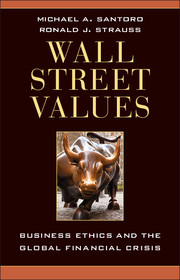Book contents
- Frontmatter
- Contents
- Preface
- Acknowledgments
- Part One Background and Theoretical Framework
- Part Two Wall Street Business Model, Regulation, and Values in Transition
- Chapter Three The Gathering Storm
- Chapter Four From Financial Services to Proprietary Trading
- Chapter Five Secrets and Lies
- Part Three Policy Recommendations and Sustainable Values for Wall Street in the Twenty-First Century
- Notes
- Index
Chapter Five - Secrets and Lies
Goldman Sachs and the Death of the Honest Broker
from Part Two - Wall Street Business Model, Regulation, and Values in Transition
Published online by Cambridge University Press: 05 February 2013
- Frontmatter
- Contents
- Preface
- Acknowledgments
- Part One Background and Theoretical Framework
- Part Two Wall Street Business Model, Regulation, and Values in Transition
- Chapter Three The Gathering Storm
- Chapter Four From Financial Services to Proprietary Trading
- Chapter Five Secrets and Lies
- Part Three Policy Recommendations and Sustainable Values for Wall Street in the Twenty-First Century
- Notes
- Index
Summary
Introduction
The turn of the millennium brought about radical change in the relationships of Wall Street firms with customers as well as to the broader economy and society – from clients to counterparties, from long-term relationships to transactional business, from guardians of efficient markets to exploiters of markets. In the postmillennial era, Wall Street firms exploit their expertise through proprietary principal transactions with counterparties whose interests are often in direct conflict with the firm. Transactions in which a firm’s expertise is shared with clients have become less important to the bottom line. Wall Street has, as a consequence, become less fit to fulfill its crucial free market roles of disseminating information about market value and serving as a vehicle for the efficient allocation of capital.
Ironically, Wall Street in the postmillennial age prospers by creating and exploiting inefficiencies in the free market and not by helping it work efficiently. The new Wall Street model requires firms to withhold information and analysis from those with whom they conduct business. When the alignment of interests between Wall Street firms and customers was severed so too was the crucial link that enabled information to flow through the financial markets. There were still functioning financial markets that valued assets. However, particularly in relatively illiquid and opaque markets such as that for mortgage-backed securities, the postmillennial Wall Street model has embedded within it unprecedented incentives to lie and keep secrets from the market in the hopes of gaining temporary profits from resulting informational asymmetries and inefficiencies. As a result, Wall Street transactions sometimes obscure markets rather than provide information about them.
- Type
- Chapter
- Information
- Wall Street ValuesBusiness Ethics and the Global Financial Crisis, pp. 114 - 152Publisher: Cambridge University PressPrint publication year: 2012



